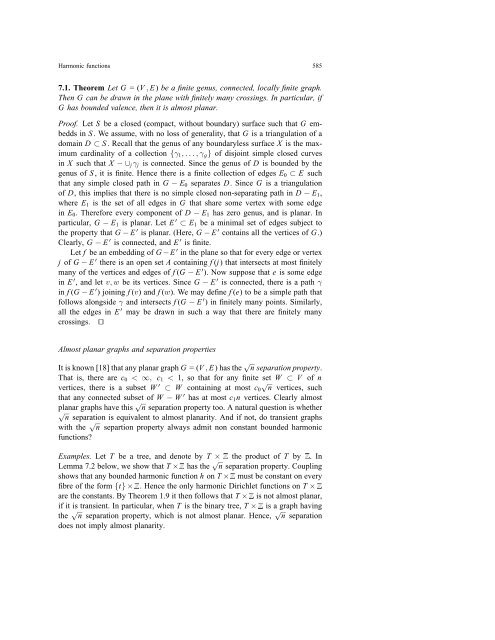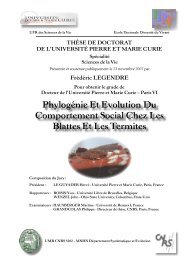Harmonic functions on planar and almost planar graphs and ...
Harmonic functions on planar and almost planar graphs and ...
Harmonic functions on planar and almost planar graphs and ...
You also want an ePaper? Increase the reach of your titles
YUMPU automatically turns print PDFs into web optimized ePapers that Google loves.
<str<strong>on</strong>g>Harm<strong>on</strong>ic</str<strong>on</strong>g> <str<strong>on</strong>g>functi<strong>on</strong>s</str<strong>on</strong>g> 5857.1. Theorem Let G =(V,E)be a finite genus, c<strong>on</strong>nected, locally finite graph.Then G can be drawn in the plane with finitely many crossings. In particular, ifG has bounded valence, then it is <strong>almost</strong> <strong>planar</strong>.Proof. Let S be a closed (compact, without boundary) surface such that G embeddsin S . We assume, with no loss of generality, that G is a triangulati<strong>on</strong> of adomain D ⊂ S . Recall that the genus of any boundaryless surface X is the maximumcardinality of a collecti<strong>on</strong> {γ 1 ,...,γ g } of disjoint simple closed curvesin X such that X −∪ j γ j is c<strong>on</strong>nected. Since the genus of D is bounded by thegenus of S , it is finite. Hence there is a finite collecti<strong>on</strong> of edges E 0 ⊂ E suchthat any simple closed path in G − E 0 separates D. Since G is a triangulati<strong>on</strong>of D, this implies that there is no simple closed n<strong>on</strong>-separating path in D − E 1 ,where E 1 is the set of all edges in G that share some vertex with some edgein E 0 . Therefore every comp<strong>on</strong>ent of D − E 1 has zero genus, <strong>and</strong> is <strong>planar</strong>. Inparticular, G − E 1 is <strong>planar</strong>. Let E ′ ⊂ E 1 be a minimal set of edges subject tothe property that G − E ′ is <strong>planar</strong>. (Here, G − E ′ c<strong>on</strong>tains all the vertices of G.)Clearly, G − E ′ is c<strong>on</strong>nected, <strong>and</strong> E ′ is finite.Let f be an embedding of G −E ′ in the plane so that for every edge or vertexj of G − E ′ there is an open set A c<strong>on</strong>taining f (j ) that intersects at most finitelymany of the vertices <strong>and</strong> edges of f (G − E ′ ). Now suppose that e is some edgein E ′ , <strong>and</strong> let v, w be its vertices. Since G − E ′ is c<strong>on</strong>nected, there is a path γin f (G − E ′ ) joining f (v) <strong>and</strong> f (w). We may define f (e) to be a simple path thatfollows al<strong>on</strong>gside γ <strong>and</strong> intersects f (G − E ′ ) in finitely many points. Similarly,all the edges in E ′ may be drawn in such a way that there are finitely manycrossings. ⊓⊔Almost <strong>planar</strong> <strong>graphs</strong> <strong>and</strong> separati<strong>on</strong> propertiesIt is known [18] that any <strong>planar</strong> graph G =(V,E) has the √ n separati<strong>on</strong> property.That is, there are c 0 < ∞, c 1 < 1, so that for any finite set W ⊂ V of nvertices, there is a subset W ′√⊂ W c<strong>on</strong>taining at most c 0 n vertices, suchthat any c<strong>on</strong>nected subset of W − W ′ has at most c 1 n vertices. Clearly <strong>almost</strong><strong>planar</strong> <strong>graphs</strong> have this √ n separati<strong>on</strong> property too. A natural questi<strong>on</strong> is whether√ n separati<strong>on</strong> is equivalent to <strong>almost</strong> <strong>planar</strong>ity. And if not, do transient <strong>graphs</strong>with the √ n separti<strong>on</strong> property always admit n<strong>on</strong> c<strong>on</strong>stant bounded harm<strong>on</strong>ic<str<strong>on</strong>g>functi<strong>on</strong>s</str<strong>on</strong>g>?Examples. Let T be a tree, <strong>and</strong> denote by T × Z the product of T by Z. InLemma 7.2 below, we show that T × Z has the √ n separati<strong>on</strong> property. Couplingshows that any bounded harm<strong>on</strong>ic functi<strong>on</strong> h <strong>on</strong> T ×Z must be c<strong>on</strong>stant <strong>on</strong> everyfibre of the form {t}×Z. Hence the <strong>on</strong>ly harm<strong>on</strong>ic Dirichlet <str<strong>on</strong>g>functi<strong>on</strong>s</str<strong>on</strong>g> <strong>on</strong> T × Zare the c<strong>on</strong>stants. By Theorem 1.9 it then follows that T × Z is not <strong>almost</strong> <strong>planar</strong>,if it is transient. In particular, when T is the binary tree, T × Z is a graph havingthe √ n separati<strong>on</strong> property, which is not <strong>almost</strong> <strong>planar</strong>. Hence, √ n separati<strong>on</strong>does not imply <strong>almost</strong> <strong>planar</strong>ity.
















